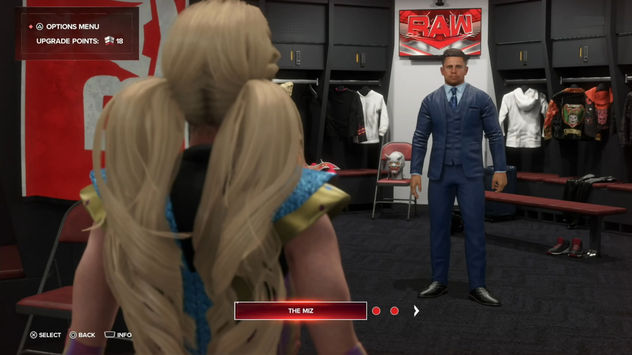
WWE 2K24
In 2023 and 2024, I was a Story Designer on the team making MyRise, the singleplayer story-mode of WWE 2K24. My responsibilities were to develop the story and support its component parts such as missions, characters, dialogues, and cutscenes. I owned sections of the story we called "Storylines," meaning I was responsible for that content through multiple phases of development called "Passes."
Before starting the first Pass, we isolated key beats of the story and defined them as Storylines made up of Assets like matches, character hubs, and cutscenes. We used a spreadsheet to track each Storyline and all of its assets.
Next, each designer claimed Storylines. These would be their responsibility throughout development; each Asset would be implemented by them, all bugs would be tracked by them, and the whole team would trust that designer as an expert when questions about their storyline arose.
I claimed roughly 15% of the game's Storylines this way.
FIRST PASS
Our first Pass was spent adding the framework of each Storyline to our game engine. At this stage, it was only important that all story Assets were present and that none would cause a crash.
For this stage of development, the game was always necessarily in flux. When new content resulted in a crash, it was not obvious if there was an error on the part of the implementing designer and/or something under development in another department. For example, Troy Simpkin went through several revisions by the character team during our first Pass, making Assets where he was present difficult to troubleshoot. However, by keeping informed through ongoing threads and making detailed crash reports, quickly diagnosing these issues was possible. For me, this was an excellent lesson in professional communication; it's better to be vulnerable and admit when you don't know something than to spend hours trying to fix a problem by yourself.

SECOND PASS
By second Pass, it was time to finalize details like character outfits, gesture animations, and unique match objectives or conditions. This is where the majority of playtesting was done.

During second Pass, there were a few major crises. One of the most serious of these was the passing of Bray Wyatt, a key player in the story, who would now have to be removed from all Storylines. We took a look at all the affected Assets spread over the whole game and evaluated which could be salvaged by reworking their cast and which would have to be cut. Ultimately, we could only salvage Storylines that were simple enough to be fast-tracked through the Passes to catch up with the rest of development, meaning that we had to cut a great deal of good work. In this process, I internalized an important facet of design; when it comes to content being cut, personal investment is a detriment. It says more about a designer for them to cut content they were proud of than content they weren't. Sometimes the eraser is the best tool we have to create engagement.
FINAL PASS
Third Pass was for polish. Content-lock was in effect, so the scope of our work was in review of details and support for other departments, such as providing feedback on the MyRise trailer.
This was a lesson in detail-orientation. It can be easy to gloss over details after seeing the same content again and again. But especially during polish, attention to fine details is invaluable. For example, playing through Undisputed and Unleashed to view cutscenes with different player heights revealed that our camera system wasn't properly handling tall player-characters, occasionally cutting them out of frame. This was also a great opportunity to reflect on our development cycle and propose improvements, such as categorizing our gesture library and eliminating redundant documentation.

RELEASE
After the game's release there was still work to do. It was also a good time to look back on the project and
consider what we learned and what we would be doing differently going forward.

When all was said and done, my work on MyRise was a fantastic opportunity to grow as a professional. I had seen the game throughout its development and learned several valuable lessons.
1. Use your team - when you don't know the answer, it's better to ask a teammate who might know rather than lose time going it alone.
2. Cuts are crucial - sometimes, you have to cut. In these times, its best to impartially assess what the game needs, even at the expense of work you've already done.
3. Always look to improve - keep track of the ways development and communication could be made easier. The road to improvement is paved in incremental efforts.


